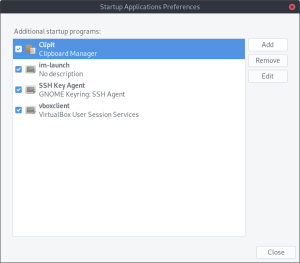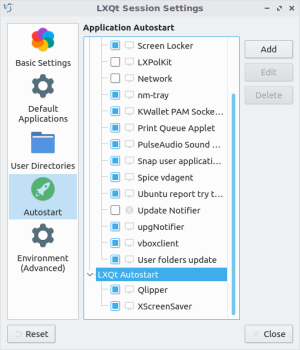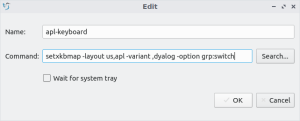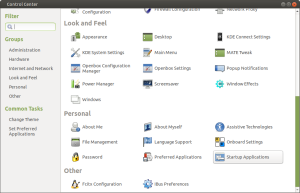Typing glyphs on Linux: Difference between revisions
(Add notes on Dyalog overriding ("hijacking") APL keyboard on Linux) |
|||
| Line 111: | Line 111: | ||
== Troubleshooting == | == Troubleshooting == | ||
=== Dyalog Overrides Current Keyboard Settings === | |||
By default, Dyalog APL overrides the current [https://www.x.org/wiki/XKB/ XKB] configuration to use the Meta ("Windows") key as the modifier for entering APL symbols. If the user manages their keyboard configuration manually using the techniques described on this page, this behavior can be quite troublesome. | |||
To run Dyalog without overriding ("hijacking") the user keyboard configuration, run <code>dyalog</code> with the <code>nokbd</code> option: | |||
<source lang=bash> | |||
dyalog -nokbd | |||
</source> | |||
=== APL Keyboard Remains After Dyalog is Closed === | |||
Dyalog overrides the current keyboard configuration, as described in [[#Dyalog_Overrides_Current_Keyboard_Settings|this section]], but fails to return the user to their previous keyboard configuration on exit. To solve this, create a custom [[wikipedia:Bash_(Unix_shell)|Bash]] script to save and revert keyboard settings upon exiting Dyalog APL:<ref>Adám Brudzewsky. [https://stackoverflow.com/questions/63431922/dyalog-apl-hijack-windows-key-and-do-not-give-it-back-fedora-32-gnome-free-lic/63433845#63433845 Stack Overflow answer]. 17 Aug, 2020</ref> | |||
<source lang=bash> | |||
OLDLAYOUT=$(setxkbmap -query | sed -n 's/^layout://p') | |||
OLDVARIANT=$(setxkbmap -query | sed -n 's/^variant://p') | |||
OLDOPTION=$(setxkbmap -query | sed -n 's/^options://p') | |||
dyalog | |||
OLDLAYOUT=$(echo $OLDLAYOUT | sed 's/^$/,/') | |||
OLDVARIANT=$(echo $OLDVARIANT | sed 's/^$/,/') | |||
setxkbmap -layout $OLDLAYOUT -variant $OLDVARIANT -option -option $OLDOPTION | |||
</source> | |||
=== Settings reverted during X Windows session === | === Settings reverted during X Windows session === | ||
Revision as of 16:06, 17 August 2020
Since mid-2012, most Linux distributions with X11 have Dyalog APL keyboard support included with the distribution,[1] using xkb, the X Keyboard Extension.[2]
setxkbmap
The simplest way to set up an APL keyboard on Linux is with the following setxkbmap command. Enter the following in your terminal emulator of choice:
setxkbmap -layout us,apl -variant ,dyalog -option grp:switch
An explanation:
-layout us,aplassignsus(U.S. English) to be the primary layout, whereasaplis secondary
-option grp:switchassigns Right Alt to switch to the secondaryapllayout when it is pressed, otherwiseusis used
-variant ,dyalogassigns the Dyalog APL variant to theapllayout which contains modifiations unique to the Dyalog language (Note the preceding comma)
A full list of keys that can be used to switch layouts is included in /usr/share/X11/xkb/rules/evdev.lst under the option category.
Note: these changes are not permanent; the user will have to select one of a myriad of methods to run the command on startup. Alternatively, if they use one of the desktop environments listed below, they can follow those instructions.
GNOME
GUI
- Open the Activities menu; this is located in the top-left corner of a default GNOME 3 session (alternatively, use your Super key to open the Activities overlay):

- Search for "startup." When the Startup Applications program is highlighted, press the Enter key to open it:

- Select the Add button on the right-hand side:

- Provide a name, enter your
setxkbmapcommand, and click Add when finished:
Terminal
- Navigate to
~/.config/autostartand create a.desktopwith any name that will help you remember its function. - Add the following to the contents of your file, customizing to suit your needs:
[Desktop Entry] Type=Application Exec=setxkbmap -layout us,apl -variant ,dyalog -option grp:switch Hidden=false NoDisplay=false X-GNOME-Autostart-enabled=true Name[en_US]=apl-keyboard Name=apl-keyboard Comment[en_US]= Comment=
LXDE
- Prepend an
@to thesetxkbmapcommand from above:@setxkbmap -layout us,apl -variant ,dyalog -option grp:switch
- Add it as a line in your user's LXDE
autostartfile, located at:~/.config/lxsession/LXDE/autostart
For Lubuntu versions up to and including 18.04 (before the LXQt split), the location of autostart is ~/.config/lxsession/Lubuntu/autostart.
LXQt
GUI
- From your LXQt panel, navigate to Preferences → LXQt Settings → Session Settings; alternatively, enter
lxqt-config-sessionin your terminal emulator. You will be greeted with the following window:
- Select the
LXQt Autostartdropdown (it will be highlighted as shown above) and click the Add button to display the following pop-up window:
- Provide a name, enter your
setxkbmapcommand, and click OK when finished.
Terminal
The above GUI approach merely creates a .desktop file in the user's ~/.config/autostart. Create your own file in the autostart directory whose contents are as follows, to replicate the functionality achieved through the GUI:
[Desktop Entry] Exec=setxkbmap -layout us,apl -variant ,dyalog -option grp:switch Name=apl-keyboard OnlyShowIn=LXQt; Type=Application Version=1.0
MATE
GUI
- Open your MATE menu (in the top-left corner of a default environment) and select Control Center at the bottom of the window:

- Scroll down through the main window, and under the Personal category, select Startup Applications:

- Click the Add button on the right-hand side:

- Provide a name, enter your
setxkbmapcommand, and click Add when finished:
Terminal
Navigate to ~/.config/autostart and create a .desktop with any name that will help you remember its function.
Add the following to the contents of your file, customizing to suit your needs:
[Desktop Entry] Type=Application Exec=setxkbmap -layout us,apl -variant ,dyalog -option grp:switch Hidden=false X-MATE-Autostart-enabled=true Name[en_US]=apl-keyboard Name=apl-keyboard Comment[en_US]= Comment= X-MATE-Autostart-Delay=0
Xfce
A tutorial specific to Xfce's config files can be found at this GitHub repository.
Troubleshooting
Dyalog Overrides Current Keyboard Settings
By default, Dyalog APL overrides the current XKB configuration to use the Meta ("Windows") key as the modifier for entering APL symbols. If the user manages their keyboard configuration manually using the techniques described on this page, this behavior can be quite troublesome.
To run Dyalog without overriding ("hijacking") the user keyboard configuration, run dyalog with the nokbd option:
dyalog -nokbd
APL Keyboard Remains After Dyalog is Closed
Dyalog overrides the current keyboard configuration, as described in this section, but fails to return the user to their previous keyboard configuration on exit. To solve this, create a custom Bash script to save and revert keyboard settings upon exiting Dyalog APL:[3]
OLDLAYOUT=$(setxkbmap -query | sed -n 's/^layout://p') OLDVARIANT=$(setxkbmap -query | sed -n 's/^variant://p') OLDOPTION=$(setxkbmap -query | sed -n 's/^options://p') dyalog OLDLAYOUT=$(echo $OLDLAYOUT | sed 's/^$/,/') OLDVARIANT=$(echo $OLDVARIANT | sed 's/^$/,/') setxkbmap -layout $OLDLAYOUT -variant $OLDVARIANT -option -option $OLDOPTION
Settings reverted during X Windows session
Since at least March 2020 there have been issues with setxkbmap settings being reset without user instruction under the X Windows System.
Below is a script written in Raku that continuously checks for this undesirable reset behavior and puts the intended settings back in place.[4]
#!/usr/bin/env raku
# Small script to ensure that APL keyboard layout is still set in xkb settings.
# Note that this is a patch for some sort of deranged time-based reset of these
# settings that is happening at a lower level of the Xorg-based Linux user experience.
#
# It's not clear what is causing these resets but this script allows us to more
# or less not care about it and get on with our hacking.
#
# Released under Artistic License by John Longwalker 2020
my $total-checks = 0;
sub xkbmap-contains-apl() {
$total-checks++;
so qx{ setxkbmap -query | grep '^layout:.*\<apl\>' }; # shell-out is easy as usual in a Perl
}
my $total-resets = 0;
sub set-xkbmap-for-apl($key, $verbose) {
say "Reset total is now {++$total-resets} -- {DateTime.now}"
if $verbose;
my $xkb-settings = chomp qx{ setxkbmap -query };
my ($layout, $variant, $options);
if $xkb-settings ~~ /^^ "layout:" \s* $<layout>=(<.graph>*) $$/ {
$layout = $<layout>.Str;
} else {
die "Aborting. The xkb settings do not specify any layout:\n$xkb-settings";
}
if $xkb-settings ~~ /^^ "variant:" \s* $<variant>=(<.graph>*) $$/ {
$variant = $<variant>.Str;
}
if $xkb-settings ~~ /^^ "options:" \s* $<options>=(<.graph>*) $$/ {
$options = $<options>.Str;
}
$layout = ($layout, 'apl').join(',');
$variant = $variant ?? ($variant, 'dyalog')
!! 'dyalog';
$options = $options ?? ($options, "grp:$key").join(',')
!! "grp:$key";
my $invocation = "setxkbmap -layout $layout -variant $variant -option $options";
say "Invocation: $invocation"
if $verbose;
qqx{ $invocation };
}
# You can use --interval, --key, and -v/--verbose on the command line.
sub MAIN(:$interval = 30, :$key = 'switch', :v($verbose) = False) {
react {
whenever Supply.interval($interval) {
set-xkbmap-for-apl($key, $verbose)
if not xkbmap-contains-apl;
}
whenever signal(SIGINT) {
say "Reset a total of $total-resets out of $total-checks checks"
if $verbose;
exit;
}
}
}
References
- ↑ Dyalog Forums. Keyboard setup on Linux. Sep 21, 2010.
- ↑ Geoff Streeter. Supporting APL keyboards on Linux. Dyalog '10.
- ↑ Adám Brudzewsky. Stack Overflow answer. 17 Aug, 2020
- ↑ John Longwalker. 5ab5traction5 blog. Raku to the Rescue: APL Keyboard Keeper. 29 Jun, 2020
| APL development [edit] | |
|---|---|
| Interface | Session ∙ Typing glyphs (on Linux) ∙ Fonts ∙ Text editors |
| Publications | Introductions ∙ Learning resources ∙ Simple examples ∙ Advanced examples ∙ Mnemonics ∙ ISO 8485:1989 ∙ ISO/IEC 13751:2001 ∙ A Dictionary of APL ∙ Case studies ∙ Documentation suites ∙ Books ∙ Papers ∙ Videos ∙ APL Quote Quad ∙ Vector journal ∙ Terminology (Chinese, German) ∙ Neural networks ∙ Error trapping with Dyalog APL (in forms) |
| Sharing code | Backwards compatibility ∙ APLcart ∙ APLTree ∙ APL-Cation ∙ Dfns workspace ∙ Tatin ∙ Cider |
| Implementation | Resources ∙ Open-source ∙ Magic function ∙ Performance ∙ APL hardware |
| Developers | Timeline of corporations ∙ APL2000 ∙ Dyalog ∙ IBM ∙ IPSA ∙ STSC |
| APL glyphs [edit] | |
|---|---|
| Information | Glyph ∙ Typing glyphs (on Linux) ∙ Unicode ∙ Fonts ∙ Mnemonics ∙ Overstrikes ∙ Migration level |
| Individual glyphs | Jot (∘) ∙ Right Shoe (⊃) ∙ Up Arrow (↑) ∙ Zilde (⍬) ∙ High minus (¯) ∙ Dot (.) ∙ Del (∇)
|